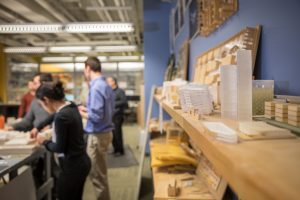May 4, 2018
Reading Time: 3 minutes
HDR @2018 Dan Schwalm
by Amy LaMar
We have all seen the models that architecture firms produce and display in their offices. But have you ever thought about what actually goes into making these models and who is behind the work?
The work has gone from a largely handcrafted affair to a more technologically sophisticated enterprise, thanks to the introduction of the computer, laser-cutting techniques and the advent of 3D printing. Yet the artistry behind the production of the models has remained the same.
“Each model must be engineered to convey a particular idea to both the designers and to the client,” said Nabil Katrajian, AIA, design principal in HDR’s Princeton office. “Every week it’s a different project. It’s always interesting to me.”
Project by project, this operation, which always involves a team of designers and architects, is making a big impact on HDR’s business, its clients and the buildings that the firm designs. The impact can be measured in three ways.
First is the number of models produced. On average, 50 models per year—or one per week—are made in the Princeton shop. Each one is approximately 20×30 inches, and between two and four versions of the same model are made for each client.
The process starts with a conversation between the model-makers and the lead architect on the project. From there, HDR’s design team turns sketches into a model of wood, plexiglass and/or, increasingly, 3D-printed material.
“Our design philosophy prides itself on seeking creative alternative solutions to any given design challenge,” said Diego Samuel, AIA, design principal in HDR’s Princeton office. “Working through the physical model allows teams to gain a better grasp for scale, proportion and materials in a way that can’t be replicated through a computer or even virtual reality.”
Second is the number of locations to which these models are shipped. As the only model shop serving all 225+ of HDR’s locations around the world, the Princeton team could be shipping a model to Omaha, Nebraska one week and China the next.
The logistics involved with shipping the model of the Los Angeles Union Station last summer, for example, are mind-boggling. The 6×8-foot model took four people an entire month to make. The final structure was shipped in two pieces from Princeton to Los Angeles in three boxes. It arrived intact and just in time for the LA office’s open house event, which more than 200 guests attended.
The third way in which the model shop is making an impact is on the designs of the buildings themselves.
“Many of the models have components that can be removed or added,” said Sean Cuddahy, AIA, senior project manager in HDR’s Princeton office. “People are able to pick up these pieces, hold them in their hands and look at them up close. This allows the client to really grasp how integral each of the components are to the success of the overall design, as well as examine different options being considered.”
“In the end, the client gets a better building because they have seen all of the angles, views, etc.,” Katrajian added. “They can get a sense of what it could be. It’s an opportunity to explore.”
It sounds like the exploration goes both ways.
By Stacey Ruhle Kliesch, AIA, AIA NJ Advocacy Consultant | Posted in Technology in Practice | Tagged: #AmyLaMar, #DiegoSamuelAIA, #HDR, #ModelShop, #NabilKatrajianAIA, #SeanCuddahyAIA, Princeton | Comments (0)
Architects are creative professionals, educated, trained, and experienced in the art and science of building design, and licensed to practice architecture. Their designs respond to client needs, wants and vision, protect public safety, provide economic value, are innovative, inspire and contribute positively to the community and the environment.

414 Riverview Plaza, Trenton, NJ 08611
(609) 393-5690
info@aia-nj.org